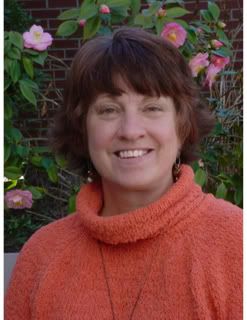Tuesday, January 30, 2007
Westminster Canterbury Richmond shares their community's "Critical Issues"
Libby Bacon Bush
Vice President of Resident Services
Libby has been at Westminster Canterbury for 14 years. As Vice President of Resident Services, she is ultimately responsible for all areas of Independent Living, Assisted Living, Wellness, Salon Services, Galleria Shops, Front Desk, and Transportation.
After graduating from the
Libby has attained her Retirement Housing Professional Certification, and is a licensed Nursing Home Administrator. She is currently enrolled in the Virginia Commonwealth University CCRC Leadership Program. She has presented over the years on various long-term care topics, including assisted living, memory support and, most recently, culture change.
Born in
1. Culture change (Project Home) impact continuum wide
2. Meeting/exceeding expectations of current and future resident generations, i.e. creating increased flexibility, independence and choice within our community
3. Recruitment, retention & management of “World Class” staff
4. Create a community wide wellness culture
5. Complete current campus renovation plans while planning for future projects, to include aging in place consideration, service creep review etc.
Labels: KEY DECISIONS, wellness program
Friday, January 26, 2007
Jan. 26th SCANPHA participants: we want to hear from you!
Following up on the “Dancing in the Rain” introduction to the Vitalife Community Wellness Program that you learned about at SCANPHA, we now need to hear from you!
Labels: CEO, DANCING IN THE RAIN, JON PERSAVICH, KEY DECISIONS, wellness program
Monday, January 08, 2007
Still Hopes' Top 5 Critical Issues
 Still Hopes’ Wellness Director Denise Heimlich lists her community’s critical issues…
Still Hopes’ Wellness Director Denise Heimlich lists her community’s critical issues…Top 5 critical is
1. Overcoming the stigma relating to mental and emotional health. We must educate on how mental and emotional health impact physical health and get people to take this seriously. Problems must be confessed and the sufferer must feel motivated to seek help and understand that solutions are possible. Depression, anxiety, low self-esteem, lack of purpose, etc. are major problems in the population, regardless of age, but are typically viewed by the sufferer as personal failure that must be hidden. Older adults must understand that these types of problems are different from dementia and feel secure that he or she will not be moved into dementia units because they are crazy.
We professionals must have access to resources to help people. We must offer support groups, and counseling. First and foremost, we must make residents understand that we are all working toward improved mental and emotional health (at least I am!) This is a continuing journey in which each person must take an active part and personal responsibility.
2. Matching dining room food choices to nutritional education. Where I work, the registered dietician and I are having trouble offering nutritional education because the residents cannot fully use this information with the limited number of dining selections available. Some of our residents and staff really want to make healthier food choices, but their selections are limited.
3. Residents isolating themselves within their level of care and ostracizing those in higher levels of care. This attitude does not fit in a wellness model. There is no spirit of community that encompasses the entire campus. Not enough independent living residents volunteer to help those residents in higher levels of care and do not welcome “able” assisted-living or skilled nursing residents into IL activities. This problem leads into the problem listed as number 4:
4. Residents hiding or denying disability in order to remain designated as Independent. Health and longevity can increase if one is getting needed support. There may be solutions within IL or moving to another level of care may cause that disabled person to thrive again. I’m really tired of residents working against themselves and driving down their own fitness and health or that of their spouse just to hang on by fingernails in an IL cottage or apartment.
5. More effective pain relief and reduced pain medication. Pain stems from many causes such as osteo and rheumatoid arthritis, spinal stenosis, muscle imbalance, and fibromyalgia, but is typically medically treated with only pain medication or surgery. Valid research has shown that pain can be eliminated or reduced with alternative therapies such as exercise, massage, yoga, meditation, humor, and many other methods. A significant portion of the older adult population has pain, but is uneducated about how an individual can positively or negatively influence his or her own pain. The burden of education for pain relief seems to fall to us since the traditional medical community remains woefully insufficient in this matter. We must first educate ourselves so that we don’t fall victim to charlatans and false research. In my region, there seems to be few resources for alternative therapies. We have a Pain Clinic in my community that is sanctioned by a local hospital. My excitement upon learning about this clinic has turned to disappointment because, to date, I have observed only pain medication being dispensed from there. I have seen no evidence of biofeedback, exercise or yoga recommendations, or any other non-medical/non-pharmaceutical solutions. Additionally, my region does not have many alternative therapy practitioners. I have taken upon myself the task of pain education and have begun to relay this information to my community.
Labels: KEY DECISIONS, wellness program
Wednesday, September 20, 2006
The key issues that the CCRC and AARC leadership focus on are fairly typical, depending on where they are relative to their operational and historic timeline. For example, are they a new community? Are they an older community trying to defend their marketplace and reposition themselves? Are they small or large, poor or affluent, urban or rural? The issues may vary but they have a great deal in common.
Regardless of the circumstances and status of a given community, there are many important facets of successful communities that need to be considered if transitional communities seek to grow and sustain. They are: the overall market needs, marketing strategies, cost and availability of money, enabling / impacting legislation at state and federal levels, recruiting and retaining employees, liability exposure, and operational techniques as well as new service dimensions.
The paramount concern in all communities shifts, as does our economy. Issues shift as well when new cohort generations begin thinking about retirement. Therefore, state of the union in the senior industry is not static, but is constantly evolving. We have asked some key leaders in the CCRC industry (CEO’s) to define for us the following:
1.What are the five most important issues that concern you within your own community operation today?
2.What are the five most important issues that concern you within our senior retirement services industry today?
Our first guest commentator is Steve Shields, CEO of Meadowlark Hills in Manhattan Kansas. Steve is a well know visionary in the industry because of his passion to deinstitutionalize care service models and replace them with more personal home-like environments. Steve explains [with generic CCRC protocol and modeling],"we're not caring for our old, we’re warehousing them."
Steve, who has co-authored a book with LaVrene Norton, entitled, In pursuit of the Sunbeam – A practical Guide to Transformation from Institutional to Household, has written a dramatic and poignant directive regarding attitude and cultural change that he feels, personally, needs to be accommodated with a sense of urgency that is hard to refute.
Steve Shields is the President/CEO of Meadowlark Hills Retirement Community in Manhattan, Kansas and a sought-after national speaker and presenter on leadership and transformation in long-term care. Meadowlark has become a national leader in the creation of a resident-directed model and conducts day long education seminars on site to educate providers on the model and its application. Participants from 37 states and 12 foreign countries have utilized this experience to further deepen their culture change journeys. Shields is on the faculty of the Kansas State University’s Center on Aging where he teaches Leadership in Long-Term Care and is also on the Center’s Advisory Board. Shields is a member of the Pioneer Board. Shields provides presentations, retreats, and strategic planning services surrounding organizational transformation by nationally and internationally. Steve graduated from Kansas State University with a Bachelor of Science degree. Major: Social Work; Secondary Major Gerontology; Emphasis study: Long-Term Care Administration. Contact Steve @ steve.shields@meadowlark.org |
Labels: KEY DECISIONS, wellness program
Friday, May 26, 2006
CCRC: KEY DECISIONS SEMINAR
Many aging communities are in the throes of realization that without Repositioning (Reformation) they will remain in harms way and go out of business if they do not effect dramatic and immediate changes in their business plan. The emerging elder market is more sophisticated, has more choices and therefore is more demanding and will not settle for the products of yesterday.
The economy is edging towards its cyclical pinnacle which means we will be going - in the near future - into the downward side of the curve, which means new strategies will have to be considered to enable us to go forward; these strategies will be dramatically different from those we utilized on the upside of the economic curve.
THW, the IPP team of providers and many of our client alumina, have decided that we need to replicate the successes of our earlier problems solving and apply those techniques to mapping out a mutual strategy for the challenging years ahead.
To this end we are announcing a seminar academy that will be unlike any you have ever experienced before; one allied and linked to a university curricula, in which you will be invited to be both professor and colleague to and with your peer colleagues. It will be called:
CCRC; KEY DECISIONS SEMINARS
This Seminar is meant to be the beginning of an ACADEMY of experienced CEO’s who have successfully (or not successfully) gone through the experience of reformation.
It is our idea that this core group can become a critical resource for our industry and other CEO’s who are too often left stunned by the revelations discovered once they take the reins of the new communities they have been hired to steer.
As discovery and events unfold, there are often revelations of incredible circumstances that pose challenges that are far and above either the training or the experience of operational administrators who find these to be new challenges.
To help us go forward, we want you to design the course that would be most meaningful for you and your fellow colleagues. Therefore we are starting this blog, to identify the key issues, and pivotal decision points that arise in the repositioning and reformation of an older community as it revamps to face tomorrows market challenges.
In 2005 & 2006 to date, the trend towards repositioning (also sometimes known as redevelopment) the aging senior living campus continues to accelerate. In metro-Chicago, in particular, a number of sizable projects are currently under development, including the largest single repositioning project yet financed – $146 million for Plymouth Place in December, 2005. This unprecedented activity is expanding our body of knowledge, thereby increasing the speed and efficiency with which future projects are coming to fruition. In this two-part Z-News, we examine the Plymouth Place project to understand some of the common elements behind many successful repositioning projects.
____________________________
Labels: KEY DECISIONS, wellness program


